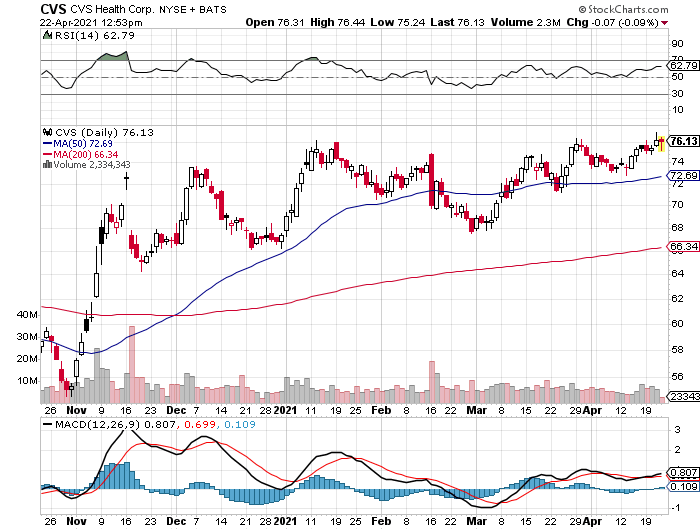Collect Cash On This Undervalued Business
Shares of this business will not stay cheap for long.
Selling put options is a great way to generate income and solid annualized returns by taking less risk than owning the same amount of common stock long. When I look for these trades I target earning 2% or more for every 30 days of expiration time.
Selling a put option is a strategy where you are slightly bullish on a stock and this reduces your risk by being able to name the price (called the strike price) you are willing to pay for the company. This contract is valid for a specific amount of time called the expiration date.
These terms are set by you and for agreeing you are paid upfront for the potential obligation to buy 100 shares of stock for every put sold. I typically look at options expiration dates between two weeks and two months.
Health Care Stocks Are Rising Again.
These stocks are up an average of 5% so far in April. This performance is strong, sending the index to new all time highs and better than the S&P 500.
CVS Health (CVS) a $99 billion health care giant.
With neally 10,000 stores it is the world's largest retail drugstore and one of the largest pharmacy benefit manages (PBMs) in the US. The company also became a major player in health insurance with the purchase of Aetna in 2017. Finally the company has a growing MinuteClinics (about 1,100 stores) for quick check up and vaccine delivery.
CVS is purposefully building a one stop shop for all your health care needs from insurance to pharmacy. This strategy is called vertical integration leading to increased profits while being able to control costs and quality of care.
Shares are dirt cheap today trading at EV/EBITDA ratio of 8.4 compared to S&P 500 ratio of 20.3 and health care index ratio of 19. Do not expect shares to stay dirt cheap forever.
The share price has been consolidating near recent highs for several months and could lead to a break out soon.

I do not want to take a directional bet that shares will move higher in the near term so instead I will collect cash from a slightly bullish to neutral strategy by selling put options.
Sell to open May 21 $75 puts on CVS for $1.55 or better using a limit order. You are paid 2.1% upfront on your purchase obligation and will buy shares at a small discount to yesterdays trading price.
At expiration if shares are above $75: put sellers will keep the $1.55 for a 26% annualized return. You can now use your capital for another opportunity.
At expiration if shares are below $75: put sellers will buy shares at a 3.6% discount to yesterday's closing price (based on your adjusted cost basis of $75 - $1.55 premium received).
I would be happy with either outcome. If I have to buy cheap shares a little cheaper then I can ride the share price higher while earning dividend payments and potentially selling covered calls along the way.
For protection use a stop loss at $55.09 (about 25% below your adjust cost basis). The company will be at new recent lows and more downside would be likely.
Take advantage of this health care giant and collect cash today.


Disclosure: I wrote this article myself, and it expresses my own opinions. I have no business relationship with any company whose stock is mentioned in this article. The information provided should NOT be considered advice. The topics discussed are risky and have the potential to lose a substantial amount. I am not an investment professional and therefore do not offer individual financial advice. Please do your own research before investing.

Need a Hive account? Sign up free here!
Posted Using LeoFinance Beta
Option selling to me has always seemed super risky. I have looked at using them to take risky bets with small amounts of capital that I expect to lose, but am willing to for the chance I am right. I must be missing the way to protect your position and not be left holding a bag you can't unload.
Posted Using LeoFinance Beta
This strategy can be super risky if you use leverage (margin loans) to have more stock exposure than you can afford to buy at any given time.
As long as you do not use margin loans or other forms of leverage, put selling is actually safer than buying the same 100 shares of stock outright because you are paid upfront for agreeing to buy shares at the price you find is attractive.
Please read my CVS example again. If you like this company and are willing to buy 100 shares of stock today, you can either buy the shares at the market and own them right away or sell a put option which expires in future weeks and get paid while you wait for your strike price (maybe think of it as a type of limit order) to either exercise.
At the end of these too scenarios you own 100 shares of stock: however the stock outright cost $76 per share ($7600) while the shares put to you only cost $75-$1.55 per share or $7345. Clearly the position where you have a lower cost basis is actually taking on less risk only $7345 verse $7600.
This is how I think about put selling. Hope this helps.
Posted Using LeoFinance Beta
Well, I have read it again but still don't understand how there isn't more risk selling naked puts. If the stock price falls, your losses rise until you cap when the share price is 0.
I see how you frame it that you can get paid and own the shares, but I might end up.owning them and immediately be underwater.in the trade. I guess that risk is the same as owning the shares unless you have trailing stop losses in place.
Posted Using LeoFinance Beta
bad reply.